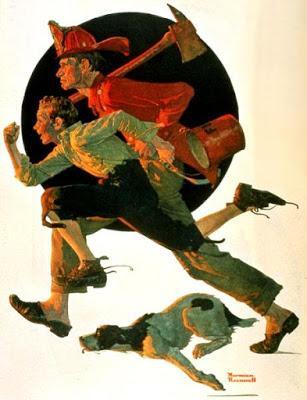
Fire Rescue by Norman Rockwell*
My latest episode of mental distress started last spring. In spite of eight hours of sleep a night and eating healthy 90% of the time, I felt tired, irritated, and mentally fogged. My digestion was off and I was experiencing road “irritation” (thankfully, many degrees away from road “rage”). I just wanted my days to be over so I could plop on the sofa, do jigsaw puzzles on my iPad, and "check out."I needed to change something. To help me find out what and why, I turned to the koshas (or kosa). This model, a multi-dimensional view of the human being at all levels, has its roots in the Taittirya Upanishad and predates the Yoga Sutras by 1000 years (see Working with the Witness). The levels (or bodies) are:
- Physical Body (anamayakosha)
- Breath-Energy Body (pranamayakosha)
- Mental-Emotional Body (manomayakosha)
- Wisdom-Witness Body (vijnyanamayakosha)
- Bliss Body (anandamayakosha)
Physical Body: Episodes of acid reflux and constipation resulting from poor digestion.
Breath-Energy Body: My breathing, at times, was shallow and I felt drained.
Mental-Emotional Body: My thoughts and feelings were moving between states of irritation, impatience, and a feeling of failure.
Bliss Body: I felt generally disconnected and out of sorts.
What to do? Certainly I could turn to my yoga practice. The importance of using yoga to balance and integrate the koshas is implicit in Iyengar’s words:
“It is essential for the follower of the yoga journey to understand the need for integration and balance in the kosa. For example, the mental and intellectual bodies (manomaya and vijnanamaya kosa) must function effectively in order for us to observe, analyze and reflect what is happening in the physical and energetic bodies (anamaya and pranamaya kosa) and make adjustments.”
An adjustment was SO needed. Yes, Legs Up the Wall pose would calm my mind, but I also needed to get to the root of the distress so I could figure out what needed to change. I turned to what I call SOS!
SOS is the international distress signal and also the acronym for “Stop, Observe, Surrender,” another name for a deeper dive into the koshas. It’s an anywhere, anytime, on or off the mat yoga technique.
Stop: Slow down, pause, and create space to breathe and simply be. This is reminiscent of the mindfulness phrase, “Don’t just do something, sit there.”
Observe: Use the Witness-Wisdom body to:
- Notice, sense, and feel all the connection points between your physical body and any surface your body touches. Examine each point. Become aware of texture, pressure, shape, boundaries, and sensation (anamayakosha).
- Take a moment or two to follow the breath in and out of your body, noticing all four parts of the breath: the inhalation, the slight pause before the exhalation, the exhalation, and the slight pause before the inhalation (pranamayakosha).
- Check in with your mind and notice the flow and content of thoughts and the prevalent feeling state/s or emotions (manomayakosha).
I practice this mostly off the mat several times a day when I need to. Great opportunities to do this occur while standing in checkout lines, sitting and waiting for appointments, or lying in bed after lights out and before sleep. After a few days of practice, the answer floated up from my subconscious. Turns out it was my current work and volunteer schedule. It was feeling heavy, mundane, obligatory, and repetitive. I’m sure I knew this at some level but was in denial since dealing with the issue would most likely mean saying no to something I’d happily said yes to and disappointing others, which as a recovering perfectionist (see Yoga Therapy for Perfectionism) is difficult for me to do. The SOS practice helped soften the denial, and open my conscious mind to accept this reality.
Right action meant simplifying and re-aligning my schedule. Once I accepted that, the irritation, tiredness, and mental fog lifted, and I’ve been able to enjoy my daily journey while in the process of re-organizing my schedule. And my koshas? They are feeling pretty balanced right now.
Physical Body: Sleep is easy and restful, appetite is good, digestion is balanced, and elimination is regular. My massage therapist noted after my last session, “You must be doing something right. The knots in your back are gone.”
Breath-Energy Body: My breathing is slow, deep, and easy.
Mental-Emotional Body: The mind is calm and peaceful. I see my life working for good.
Wisdom-Witness Body: With the new awareness, I can release the need to distract myself. I still do my jigsaw puzzles but for fun and not as a “check out” activity.
Bliss Body: I feel joy and a sense of being connected and content.
Subscribe to Yoga for Healthy Aging by Email ° Follow Yoga for Healthy Aging on Facebook ° Join this site with Google Friend Connect

